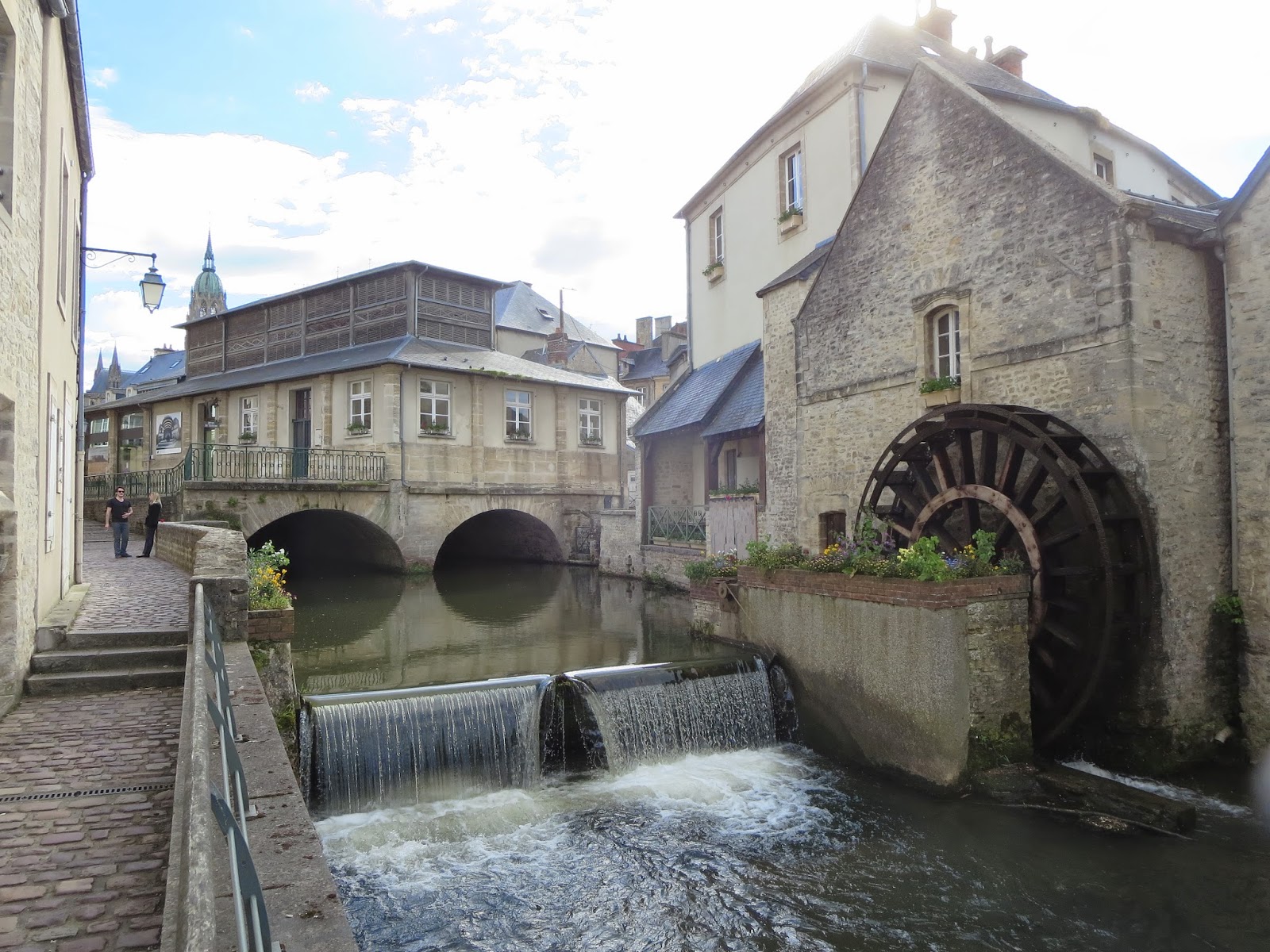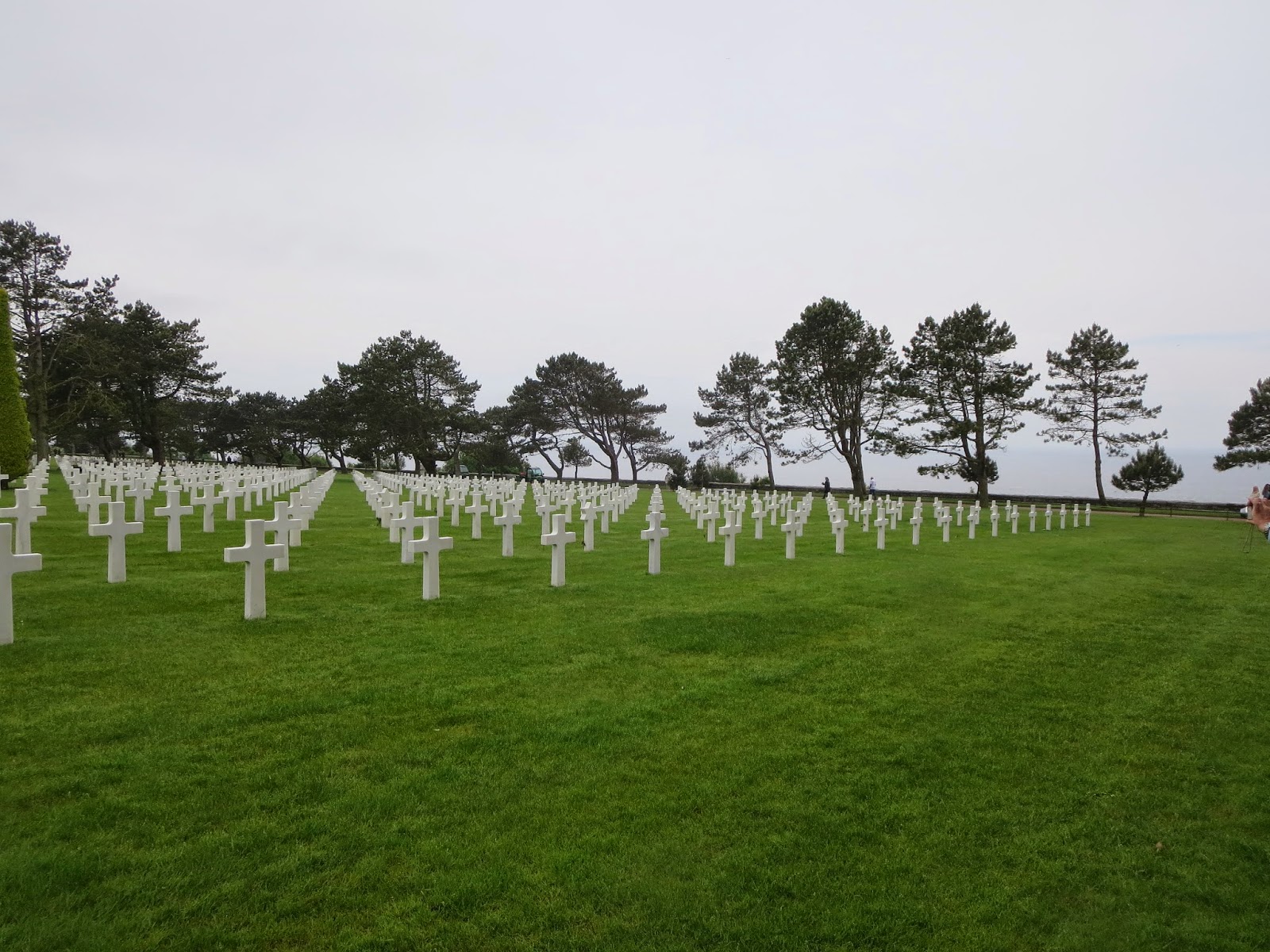I'm writing this as we wing our way home on Sunday the 25th, but it's all really well in my memory so it won't be hard to relate things here. We spent 4 days in Bayeux so I might break this into two separate posts. I don't know if you have figured out that I'm doing these from my smart phone without a blue tooth keyboard - and it's one finger pecking unlike what teenagers seem able to do. So I think for both you and I two parts will be better!
Our plan for the Bayeux stay was for day 1 to be a mid day arrival from MSM and to do a guided, 2 hour walking tour of the city. Day 2 was planned as a professionally guided, all day, small group tour of the American invasion beaches as well as some of the key American paratroop sites. This day was locked in schedule-wise. Days 3 & 4 were weather dependent and to include one day for tours of the Bayeux tapestry and the Bayeux cathedral, then one day for a revisit to the American military cemetery, Omaha beach and a small village of special interest to me (more on that later). The Bayeux days were tue-wed-thurs -fri of this last week. So that is pretty much what we did and the weather was amazingly cooperative.
I have to say that I was pretty worried about the weather. We had been VERY lucky so far with mostly sun or part sun and just a sprinkle that was hardly worth an umbrella. Unfortunately the forecast for Bayeux looked like full rain. As it turned out the forecasting in Normandy - off the channel - is notoriously difficult. History should have keyed me to this as Eisenhower had a similar problem! So to save the suspense there was only an occasional sprinkle, one brief downpour while we were in a museum, and sun or partly sun the rest! Amazing luck.
So after an enjoyable drive up from MSM we arrived about lunch time Tuesday and a quick bite before the 2PM walking tour start. Just a quick note on the drive. I deviated from the GPS route so we could go by St. Lo which was the site of the American battle to break out of Normandy. This "detour" also enabled some good back road views of the Norman countryside. All of these places such as St. Lo have some very interesting stories attached to them, but I can't really do all of them here. I'd be happy to give any of you some of these if you'd be interested.
Our hotel in Bayeux was the Rhein Mathilde which means Queen Mathilde who was the wife of William the Conqueror. Both of these two played an important part of Bayeux's history. The hotel turned out to be a really good choice as it was very nice, a great location and had a good restaurant.
The walking tour was something I had discovered browsing the web. It is called Discovery Tours. You just show up at the appointed place/time, pay the fee and do the tour with a local guide. As it turned out Cath and I were the only ones there so we had a personal tour! Our guide was a lovely young lady and she gave a wonderful tour with lots of history and interesting sights. We would never have discovered half as much on our own. A really fun time. She was actually quizzing us as we went along to be sure we were absorbing her info. Great fun. After the tour we had evening to ourselves with lots of interesting choices of restaurants. Meals did not disappoint. There were always interesting and delicious Norman specialties on the menus and desserts were out of this world. Sorry if I'm a bit over the top here, but...
Day 2, Wednesday, was the D-Day history tour. There were several available and I chose "Overlord" tours based on recommendations - especially that of Rick Steves. By the way his guide books, hotel and restaurant recommendations were really near perfect as far as we are concerned. So the tour was a group of 8 (4 couples) in a van. The guide was a Brit (50ish) who had a personal interest and a really excellent knowledge of the invasion story. He actually lives inland a bit from Utah beach. He had many stories of events that were down to the individual or small group level which really gave a personal feel to this otherwise big story. He often took us to locations off the tour agenda to where these individual events took place - a small bridge, a stream crossing or a village church.. It really made the history of this day come alive.
I probably can't relate everything from this tour so I'll do my best with some of the highlights. I'll be happy to tell you more over cups of coffee.
First the weather. It was a somewhat overcast day, but no rain. In actuality this fit pretty well the way it was on June 6, 70 years ago. This actually gave an definite mood of realism to our visit.
Omaha beach is breathtaking. If it didn't have such a horrific story it would be described as a perfect sea-side setting. It's a 3 mile long crescent beach, tan sands, a flat wide beach at low tide (reminiscent of south NJ beaches such as Wildwood and Cape May). On clear and even mildly hazy days you can see the whole 3 mile length of the beach. Along this whole length the beach rises on a scrub/shrub covered slope to a height of about 100 - 120 feet to the flat Norman country side. Also along this length there are 5 exits off the beach. At the time of the invasion I believe only 2 or 3 of these were paved or vehicle worthy. The others had only walkable paths. These beach exits are like valleys or wide gullies cut into the slope. At either end of the beach, the sloped bluff changes to abrupt cliffs with no natural exits. As to the flatness aspect of the beach it is quite amazing at low tide. It goes out as far as several HUNDRED yards. Easily 200 and possibly 300 when we were there (low tide). This was open beach, threaded with rivulets (often called runnels) and small pools.
Given this geography the beach landing was confined to the 3 mile section between the cliffs. So that is what you see today. Why land here at all? Without Omaha there would be a big gap between Utah (which was critical for the capture of the port of Cherbourg) and the Canadian beach (codenamed Gold). A gap between these beaches would have allowed the Germans to keep a separation between these forces - divide and conquer.
So back to the Omaha landing. The description I outlined above could have been for a vacation brochure, but of course when you think in terms of the invasion these features all had very different implications. Low tide was selected for the 1st waves so that the forest of beach obstacles (obstacles for the landing craft, not the troops on foot) could be blown or avoided. But this meant the troops had to run or crawl those long several hundred yards into murderous fire. The bluff along the whole beach gave the German defenders an absolutely perfect defensive situation - firing downward on the troops from above and left/right along the nicely curving beach. The exits also had significant implications. The Americans had to capture them to move equipment off the beach. But the Germans realized this too and so focused their defenses there.
So when you stand there all of this comes perfectly together. At the same time so do the contrasts of then and now - now a beautiful seaside beach, then a killing field, an impossible thing, and yet a costly success.
Let me add a few additional comments. How did it come to be a success. It almost didn't. Most of what was planned turned out to have failed. Most of the floating tanks didn't make it in to the beach - something like 3 out of 50 made it - appalling losses. The leading wave demolition engineers were only able to clear a few paths in the obstacle belts. This led to losses of many troop filled landing craft. The preliminary air bombardment completely missed the beach (remember the low overcast). The plan to focus on the beach exits via direct (frontal) assault failed due to the incredibly strong German defenses. Finally, the near total confusion from landings at wrong spots, significant losses of men and material, loss of leaders and the unexpected hail of murderous gunfire greatly affected the ability of the troops to do anything but seek survival.
The things that did work were as follows: a few incredibly brave, often leaderless, soldiers - privates, sergeants and officers - decided to scale the bluff between the exits and then attack them from behind - this worked. It wasn't in the plan,but on the ground it was the right thing to do. Also the relentless wave after wave of additional troops being landed basically overwhelmed the defences - the Germans were literally running out of ammo. And finally, the brave skippers and men of 5 navy destroyers who came to within 900 yards of the beach, some scraping the bottom, to pour, point blank, 5 inch navel gunfire at the defenses on the bluff. It took well into the afternoon for significant penetrations up the bluff and cost something like 2000 KIA and many more casualties - indeed "the longest day".
Well, it was actually much more than all of this, but this is the short version. There are many individual stories - tragedies and heroism. It really must be seen to really appreciate what happened there.
And then there is the american cemetery, just above the bluff about in the middle of the beach. I think I'll pick this up in the next posting along with Utah beach and the paratroop areas.
This first photo is taken from about half way out on Omaha beach looking back onto the bluff with the American cemetery just at the top of this bluff area.
This photo is the same scene, but taken closer in to the bluff. The American cemetery is just past the trees lining the top of the bluff.
This photo looks out onto the beach at low tide (all of these are at low tide). At the middle right side are people further out on the beach giving a sense of the distance at low tide.
A view along the beach near where the bluff begins. This scrub covered sand dune is where a rock pile used to be located that gave some cover to the troops that made it this far.
This photo is a view of the beach from the top of the bluff at the American cemetery. This is a view that the German gunners would have had, although they were dispersed all throughout the slope of the bluff. There is now a walking path from the cemetery to the beach. Cath and I took this trail when we revisited here the next day.
This is a view of a portion of the American cemetery that shows the distant channel beyond the line of trees.





























